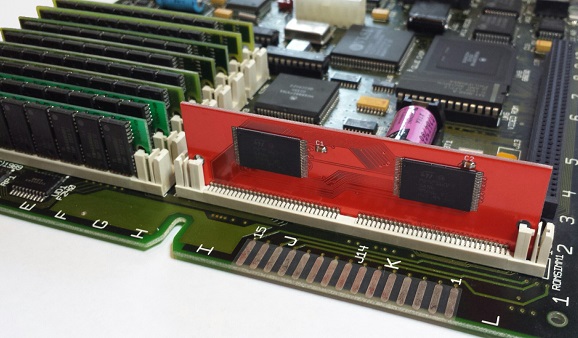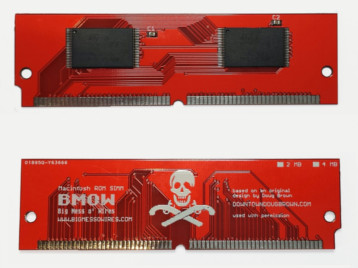Mac ROM-inator II: The Thickening


The Mac ROM-inator II is back in stock – get yours now at the BMOW Store. The ROM-inator II is a replacement ROM SIMM for Macintosh II series computers and the Mac SE/30, adding a bootable ROM disk, 32-bit cleanliness, HD20 hard disk support, and more. Read more about it at the project’s home page.
One small mystery has followed the Mac ROM SIMM project from its earliest days, even before BMOW took over the project from Doug Brown. Experience has found the Mac SE/30 to be much pickier about replacement ROM SIMMs than other Macintosh II series computers. On many SE/30 machines, the computer won’t boot with a ROM-inator II SIMM installed until the SIMM is shimmed or braced with clips or rubber bands. Why? Neither Doug nor I ever found a satisfactory answer. While it isn’t difficult to do, it’s an added step that isn’t needed for other machines.
Over the years, a few SE/30 owners have suggested the ROM-inator II SIMM is too loose in the SE/30 ROM socket, and one person had success manually tinning the SIMM pads to make them slightly thicker. I was never fully convinced about this theory. Why would it only affect the SE/30 and not other machines? And anyway the replacement SIMM was the same thickness as the original ROM SIMM (about 1.2 mm), to the limit of my caliper’s measuring abilities. The exact thickness is hard to pin down, since it varies slightly at different regions on the PCB, and there’s also a +/- 10% thickness tolerance from the manufacturer.
I recently learned something that made me reconsider the thickness theory. Back in 1970s and 1980s, PCB thickness was sometimes specified in mils (thousands of an inch) rather than in millimeters. 50 mil PCBs (1.27 mm) were a common thickness, but today these have all but disappeared. Now 1.2 mm is the closest standard thickness, and that’s what was used for all the previous generations of ROM-inator SIMMs.
Is it possible the original SE/30 SIMM was 50 mils (1.27 mm) nominal thickness, with a matching thickness socket, while all the other Macintosh II models used 1.2 mm nominal SIMMs and sockets? That would be a little surprising, but it could explain the behavior I’ve seen. With a 10% thickness tolerance, that means original SE/30 ROM SIMMs would be anywhere from 1.14 to 1.40 mm thick, and ROM-inator II SIMMs would be anywhere from 1.08 to 1.32 mm thick. It’s conceivable that the ROM-inator II SIMMs at the thin end of the distribution, under 1.14 mm thick, might have trouble in SE/30 machines.
It’s still just a theory, but it seems like a plausible one. I spoke to my local SIMM manufacturing partner about getting a thicker PCB, but unfortunately 50 mil PCBs were not available. To complicate matters further, if you’re concerned about differences of a hundredth of a millimeter, then you also need to consider the thickness of the PCB’s copper layer and any plating on the copper. Much of this calculation went over my head, but eventually my local partner was able to find a Korean manufacturer who could create a 1.27 mm stackup with 10% tolerance. The new batch of ROM-inator II SIMMs in the store today were made by that manufacturer.
So there you have it. If I’ve done this correctly, the nominal thickness of a new ROM-inator II SIMM should be a whopping 0.07 mm greater than before, an increase of about six percent. Will that do anything to help the SE/30? Especially when the thickness tolerance is still larger than the new increase in thickness? Honestly I’m not sure, but I’m interested to find out. Maybe it will behave the same as the ones from the previous manufacturer, which would be anti-climactic but fine. Or maybe it will provide some new clues for this long-running SE/30 ROM SIMM mystery.
Read 5 comments and join the conversation5 Comments so far
Leave a reply. For customer support issues, please use the Customer Support link instead of writing comments.


i been looking into this exact issue with some customs simms ive had made for me se/30, i even replaced the 64pin (or was it 68pin? i forget now) with NOS simm sockets. ive tried the shim method as well as adding a very small layer of extra solder using hot air to 1 or both sides of the simm but still ran into issues. in fact since replacing the simm socket things are more reliable but 9/10 times when i cold boot the machine it comes up with the typical Simasimac screen that implies it can’t read from the rom. but if i hit the programmers reset button on my SE/30 then 100% of the time it chimes and boots. this has led me to think that the the 25ms (or there abouts) that the sony sound chip hold reset on is not long enough to allow the roms on the simm to begin to function in time. i’ve scoped this out as well as the psu voltages and i suspect that this issue at least for some could be fixed by increasing the reset delay on the sony sound chip. ive still got more research and testing to do but i suspect its the 1uf capacitor that sets this delay. either that or a combination of that and a resistor in a RC configuration that is responsible for this ‘ruction’.
would love to hear your thoughts on this if you get the chance
Interesting theory. Based on what I’ve heard from other SE/30 owners, I think the mechanical fit / thickness theory is probably the best match with the evidence. Or there may be multiple factors at work.
sorry I meant to say capacitor c16 no c6 btw.
well there are many people that just can’t get custom roms Simms to work reliably or at all on the se/30. I’ve tried HASL and 2oz gold tinned contacts on my boards and I tried using 1.3mm pcbs with the same strange issues. my power rails when scope’d out are the same as when I use a stock apple ROM so unless there’s some capacitance issue going on I’m at a loss so far.
btw have you considered making the mega roms again? I use 3.3v logic flash on my latest Simms with bus transceivers in-between so using modern flash roms aren’t really an issue if you consider doing that, I know a lot of people aren’t handy with a soldering iron or hot air so might be worth looking into.
Hey Steve, new Rominator Simms better fit in SE30 (2 different board versions tried). Placed a new Rominator in a IICX this evening and was very very tight. Was very careful to pinch and message both sides of plastic tabs down to seat simm (hate those plastic tabs – so scared to break them!!). VERY Firm fit, but working fine. But I think your right, somehow the SE30 Rom slot ever so slightly bigger than Mac IIs (IISi, IICi, and now IICx)
I wondering If I am one of the few people here to appreciate that amazing highlander quote. Juan Sánchez-Villalobos Ramírez would have been impressed…RIP